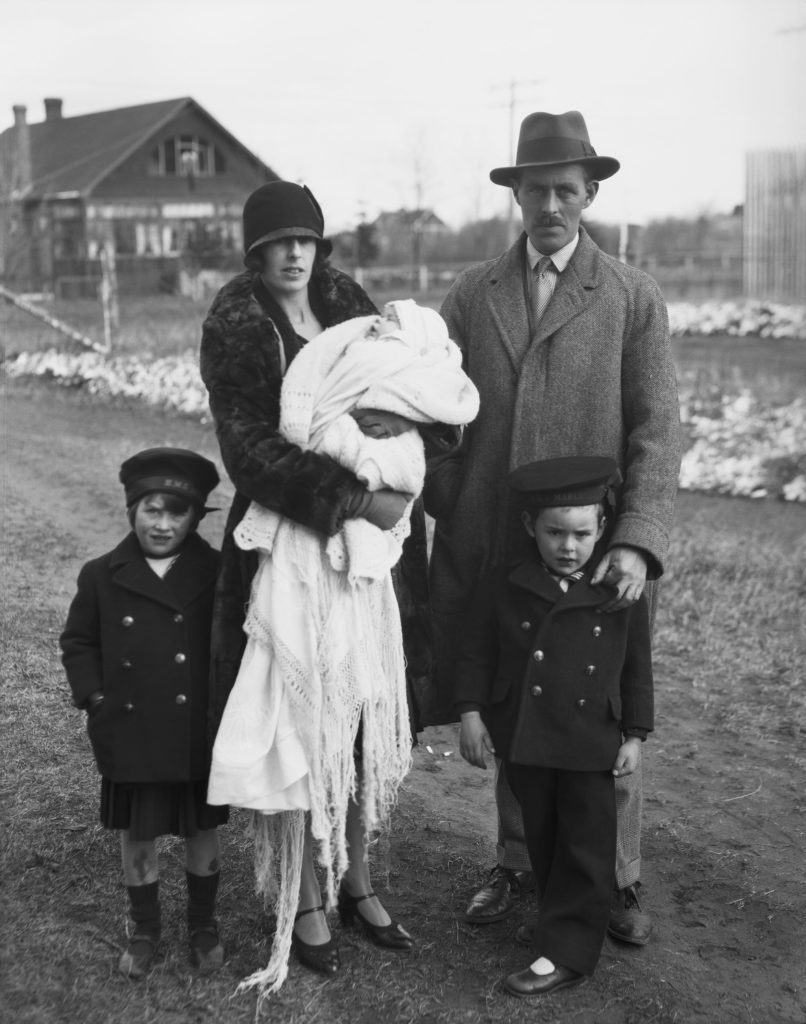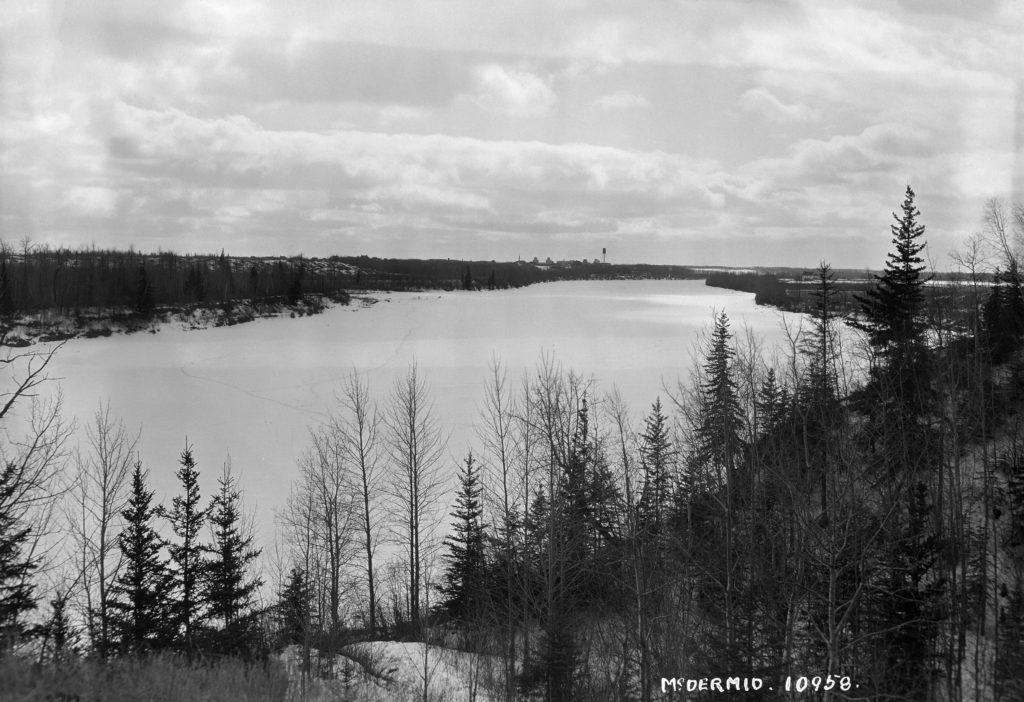
“Christening of Sylvia Rodney in Fort Saskatchewan,” 1930, [nd-3-5135a] by McDermid Studios. Courtesy of Glenbow Archives, Archives and Special Collections, University of Calgary.
Little known today, however, are the British nobles who took up residence in the Fort Saskatchewan District from 1919 to 1959. On the banks of the North Saskatchewan River at the northern end of Lamoureux, once stood the 1000 acre Cottesmore Farm. The owners were Lord and Lady Rodney. Rodney was the 8th Baron Rodney and born George Bridges Harley Guest Rodney in 1891, most likely at Berrington Hall in Leominster, Herefordshire. Lady Rodney, was Marjorie Lowther, the eldest daughter of the Honorable Launcelot Lowther, the brother and heir to the Earl of Lonsdale. She was born in 1895 in Kensington.
The first Lord Rodney had been an Admiral in the British Navy and governor of Newfoundland in 1749. He received his title and an annual pension of 2000 pounds after defeating the French and Spanish fleets at Dominica in 1782. The crown made the pension permanent ten years later until it was commuted by the British Treasury to a cash payment of 42,000 pounds sterling (a little over 2.6 million pounds in 2021) in 1924. George Bridges Rodney’s father, George Brydges Harley Dennett Rodney, became the 7th Baron Rodney in 1864 and served as a British army officer in the Egyptian and Nile Campaigns in the 1880s. In 1891, he married Corisande Evelyn Vere Guest, second daughter of Lady Cornelia Henrietta Maria Spencer-Churchill (a great-aunt to Winston Churchill) and her husband Ivor Bertie Guest, 1st Baron Wimborne. The elder Rodney managed to squander much of the family fortune away on gambling and racehorses and became abusive towards Corisande shortly after their marriage. After being struck in the eye in 1899, Corisande separated from her husband, taking with her the younger Rodney and his three brothers Simon, James, and William. She would receive a divorce by decree nisi in 1902.
In 1907, George Rodney, along with his brothers, attended Robert Baden-Powell’s first Boy Scout camp on Brownsea Island. George signed the attendance register first, making him the world’s first Boy Scout. He was unable to attend a reunion of the first camp in 1928, but in a letter addressed to Baden-Powell he intimated that “that first Boy Scout camp has always stood out as one of the landmarks of my life, representing one of the happiest fortnights of my childhood.”[1]
George’s father died in 1909, passing to him the title of Lord Rodney and the hereditary pension of 2000 pounds. A few years later, during the Great War, he would briefly follow in the footsteps of his father and his more distant ancestors by serving in the British Army as a major in the tank corps. Before the armistice of 1918, he married Marjorie and within a year the couple decided to try their fortune in the Canadian West. They arrived in Edmonton in the spring of 1919 with their infant son George and spent the first night in a hotel rather than Immigration Hall. After spending a couple of days in Edmonton, the Rodneys registered as farm help at the Government Employment Bureau. The farmer who initially hired the couple failed to show up to collect his new employees, possibly having discovered that they were a pair of inexperienced English aristocrats.[2] They managed to find a new employer in a Mr. Baker, who farmed in Lamoureax near the old bridge into Fort Saskatchewan. Over the spring and summer, the Rodneys lived in a tent on the edge of the Baker farm while George worked in the fields and Marjorie labored in the Baker’s home.
In autumn 1919, the Rodneys purchased the farm of Judge Fiset of Rimouski, Quebec, which lay at the northern end of Lamoureax. The Rodneys named the farm Cottesmore after a pack of hounds Marjorie hunted with in England. In 1924, they increased the size of the farm to 1000 acres by purchasing Ed Gaumont’s property. Gaumont’s farm had been the site of the first Fort Edmonton and Fort Augustine in 1795. The Rodney’s first winter on their new farm in 1919 was apparently one of the coldest on record, but the couple, and their infant son George, were unable to take occupancy of the only house on the farm until spring and had to winter in their tent. The family apparently suffered no “ill-effect” from living outdoors in their first Alberta winter, and despite “the hot water bottle, being frozen solid in the morning (when it fell out of bed), they never even got a cold.”[3] When the Rodneys finally moved into the farmhouse in the spring of 1920, they found it so infested with bedbugs that they held nightly “bedbug spearing competitions” using hatpins to extirpate their little vampiric foes.[4]
Despite being novice farmers with only one season under their belts, the Rodneys quickly turned Cottesmore into a successful farming operation. They were soon supplying the University Hospital in Edmonton with all their milk, sending the cans by wagon every morning to the train station in Fort Saskatchewan. The dairy operation only lasted a few years, however, and ended when the milk house burned down when Lord and Lady Rodney were away visiting England. Instead of rebuilding the milk house, the Rodneys turned their attention to a large market garden. Their daughter Diana remembers hours of hard work picking peas and beans in the blistering summer heat and her father delivering the produce by wagon to grocery stores around Edmonton.[5] The Rodneys gradually replaced the garden with fifty acres of potatoes, from which they supplied the Hotel MacDonald with all their potatoes for many years. With such a large operation, the Rodneys employed the help of neighbors and fifteen to twenty Ukrainian women from the Beverly area in Edmonton each fall to help harvest the potatoes.

“View of Fort Saskatchewan from Lord Rodney’s Farmhouse, Lamoureax, Alberta,” 1922, [nc-6-10958] McDermid Studio. Courtesy of Glenbow Archives, Archives and Special Collections, University of Calgary.
The 1920s brought another famous British dignitary to Cottesmore Farm: Winston Churchill, along with his son Randolph. In August 1929, while promoting his book The Aftermath on a lecture tour across Canada, Churchill paid his cousin George a visit. Randolph even managed to play the part of the farmer while at Cottesmore, having his photo taken riding the Rodneys’ tractor. The Rodneys also played host to numerous governors-general at the farm in the 1920s and 1930s. For these affairs, the Rodneys had inmates from the Provincial Gaol tidy up their estate and held large garden parties with a platform for dancing on the lawn.
Aside from teaching titled gentry to farm, and playing host to prestigious guests, the Rodneys were actively involved in many other aspects of their community. In the 1920s, Marjorie Rodney became the first Girl Guides Commissioner for Alberta and Lord Rodney was involved with the local Boy Scout troop. Lady Rodney also started the first crèche, or nursery, in the district during the depression.[8] Children could stay at the crèche for a cost of ten cents a day and to help finance the nursery, Lord Rodney donated vegetables and Lady Rodney raffled off decorated Christmas cakes in Edmonton. Beginning in the early 1930s, Lady Rodney also held annual Christmas parties for the children in the District. Each child received three small presents and feasted on chocolate eclairs, brandy-snaps, homemade buns and cake, all made by Lady Rodney.
During the Second World War, Cottesmore Farm played weekend home to many aviators stationed in Edmonton from England, Australia, and New Zealand. Farm help was difficult to find in wartime, so if the visiting men had any leave they spent as much as a week with the Rodneys and helped with the work around the farm. The Rodney’s two oldest sons, George and John were attending McGill University in Montreal, while Michael, Diane, and Sylvia were at school in England. At the outbreak of war, they all returned to Canada. Sylvia, born in 1930, was too young to contribute to the war effort, but her four siblings all served. George enlisted in the Royal Air Force and died in combat in 1942, at the age of 22. John served as a commando with Lord Louis Mountbatten in Burma (Myanmar), Michael joined the Royal Canadian Navy, and Diana joined the Womens’ Royal Canadian Naval Service.
In 1926, Lord Rodney spoke affectionately of his new home, confiding that he and, “Lady Rodney… are content on our farm, for here we have found happiness… we love conditions in Canada and will stick to our home in Alberta.”[9] The Rodneys expected to live out the remainder of their lives on their farm, but the war years, and the years that followed, took their toll on Cottesmore. The days of titled aristocrats living on the banks of the North Saskatchewan across from Fort Saskatchewan were drawing to a close. In 1959, Lord Rodney became seriously ill and the Rodneys decided to sell Cottesmore Farm and move to Victoria, British Columbia. There, they named their new house Cottesmore Lodge. Lady Rodney passed away in 1968 and Lord Rodney in 1973. John Rodney became the 9th Baron Rodney on his father’s passing. Michael became a prominent lawyer in Edmonton, and Diana worked as a public affairs officer for the Alberta Department of Agriculture. Sylvia moved to London and married Eric de Bellaigue, the son of Viscount Pierre de Bellaigue. The current, and 11th, Baron Rodney, is John’s grandson, John George Brydges Rodney. He was born in 1999.
[1] Steve Brobrowicz, “Be Prepared, Eh!” The Leader, August/September 2007.
[2] Diana Rodney, “The Rodneys,” in Our Treasured Roots: A History of Gibbons and Surrounding Areas (Gibbons, 1982), 316.
[3] Ibid.
[4] Ibid.
[5] Ibid. 317.
[6] Owen E. McGillicuddy, “A Lord of the North,” MacLeans, October 15, 1926. https://archive.macleans.ca/article/1926/10/15/a-lord-of-the-north. Accessed April 4, 2021.
[7] “Titled Farmers Till Canadian Prairies,” The Colborne Express, June 7, 1928.
[8] Rodney, 317.
[9] McGillicuddy.











